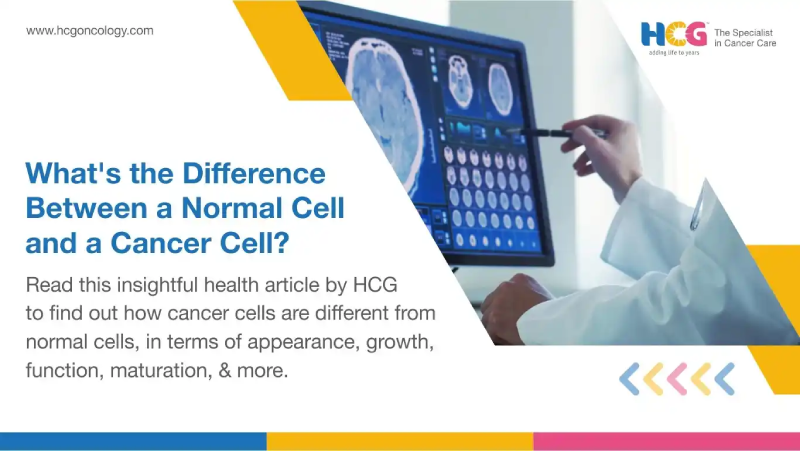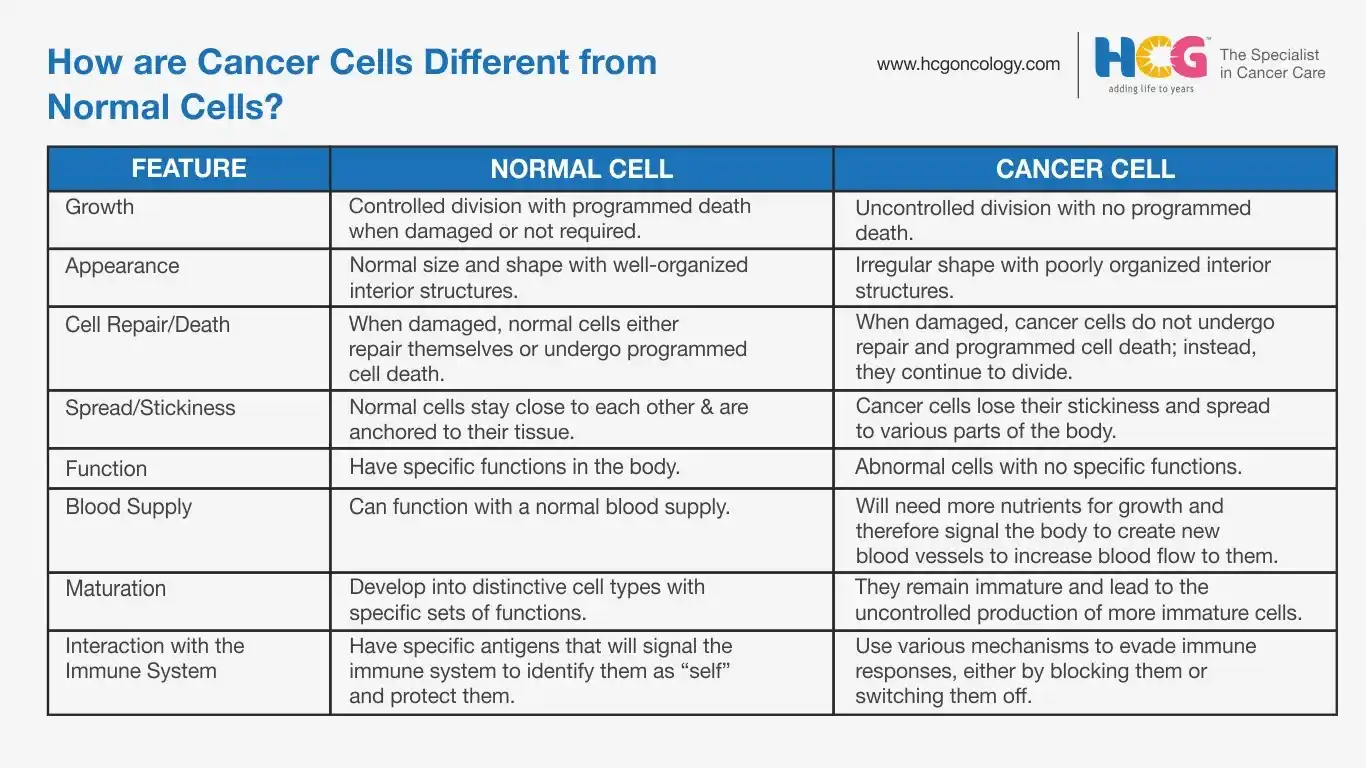
21 Oct, 2025
Feel free to reach out to us.

21 Oct, 2025
This article is medically reviewed by Dr. Kshitij Domadia, Consultant - Medical Oncology, HCG Aastha Cancer Centre.
Cancer refers to a group of diseases that cause the body’s cells to grow uncontrollably and spread to other body parts. It can start almost anywhere in the human body, which consists of trillions of cells.
Human cells grow and multiply to form new cells as the body needs them. When cells grow old or become damaged, they die, and new cells take their place.
Sometimes, this orderly process breaks down, and abnormal or damaged cells grow and multiply when they shouldn’t. These cells may form tumors, which are lumps of tissue. Tumors can be cancerous or noncancerous (benign).
Cancerous tumors spread into, or invade, nearby tissues and can travel to distant places in the body to form new tumors (a process called metastasis). Cancerous tumors may also be called malignant tumors. Many cancers form solid tumors, but cancers of the blood, such as leukemias, generally do not.
Benign tumors do not spread into, or invade, nearby tissues. When removed, benign tumors usually don’t grow back, whereas cancerous tumors sometimes do. Benign tumors can sometimes be quite large, however. Some can cause serious symptoms or be life-threatening, such as benign tumors in the brain.
Additional Reading: Early Symptoms of Cancer | HCG
The causes of cancer cell development include genetic mutations, exposure to carcinogens such as tobacco smoke, UV radiation, or certain chemicals, as well as viral infections like HPV.
These factors can damage cellular DNA and disrupt normal cell functions.
Understanding how a cancer cell is formed involves looking at how these mutations affect the cell cycle, allowing cells to bypass normal controls like apoptosis and grow uncontrollably.
As for what cancer cells look like, they often appear irregular in shape, have enlarged or multiple nuclei, and lack the organized structure seen in healthy cells, making them easily distinguishable under a microscope.
The major difference between normal cells and cancer cells is that cancer cells grow uncontrollably.
The body's immune system can't stop or kill them quickly enough to keep them from multiplying, which allows them to grow and sometimes spread.
Oncologists have an in-depth understanding of how a cancerous cell is different from a normal cell, and this helps them devise individualized treatment plans for each case.
Here are some significant differences between normal cells and cancer cells:
Cancer cells tend to divide uncontrollably and ignore the body’s signal to stop growing and multiplying.
Normally, the body uses a process called apoptosis—programmed cell death—to eliminate cells that are no longer needed. However, normal cells are better at responding and listening to the body’s cues and stopping multiplication when enough cells are present, unlike cancer cells.
Normal cells tend to look uniform in size and shape, with well-organized internal structures.
However, cancer cells in the human body often appear irregular, with abnormal shapes and disorganized interiors.
Normal cells repair themselves when they are damaged and undergo a process called apoptosis, programmed cell death.
On the other hand, cancer cells in the human body continue to live and divide even after getting damaged and avoid the process of repair.
Normal cells and cancer cells are different based on their communication.
Normal cells communicate with each other very effectively and respond to the signals of neighboring cells. Whereas cancer cells in the human body generally lose this ability and ignore signals that regulate their growth and behavior.
Generally, normal cells stay in place and are anchored to their tissue, but cancer cells lose this stickiness and break away and spread to other parts of the body.
The dynamics of a normal cell vs. a cancer cell also depend on their function. Typically, every normal cell has a specific job or function in the body. However, these roles are often absent in cancer cells, which behave abnormally or become non-functional.
Normal cells depend on the body’s standard blood supply. Cancer cells, however, can signal the body to create new blood vessels (a process called angiogenesis) to feed the growing tumors.
Normal cells mature into distinct cell types. These different cell types have specific functions. For example, liver cells help the body metabolize proteins, fats, and carbohydrates and help remove alcohol from the blood.
Cancer cells divide so quickly that they don’t have a chance to mature and become the specialized cells with specific functions.
Normal cells are typically recognized and protected by the immune system.
Cancer cells can sometimes hide from, suppress, or even manipulate the immune system, making them more difficult to destroy.
Cancer cells are invasive. Because cancer cells ignore the body’s signals to stop dividing, they start invading tissues nearby. Unlike cancer cells, normal cells know their functions and stay put.
The human body is made of hundreds of millions of cells. It is very normal for some of those cells to be abnormal, but the body has a series of processes to protect itself against them. Cancer cells are evasive. They evade the body’s natural defenses and protective mechanisms, leading to the formation of malignant tumors in different parts of the body.
Genes control how cells divide, grow, and when they die. Mutations or sudden changes in these genes can alter the cell cycle, leading to abnormal cell division.
The following are the ways an individual can have a cancer-causing genetic mutation:
Inherited from parents: Some types of cancer, such as breast cancer and ovarian cancer, are inherited in families.
The inherited gene mutation is in the egg or sperm at conception. The sperm fertilizes the egg and forms one cell. That cell divides, and the genetic mutation ends up in every single cell.
Tumor suppressor gene mutations: These inherited genetic mutations often happen in tumor suppressor genes, which typically help ensure cells divide and die at the right time.
Tumor suppressor genes also fix DNA mistakes. But if there are inherited mutations in these tumor suppressor genes, that may not happen.
Patients acquire them: Most cancers happen through acquired or somatic mutation. Instead of inheriting these mutations, they’re picked up throughout the person's lifestyle and their environmental exposures.
For example, smoking, secondhand smoke, and ultraviolet rays from the sun may cause cancers by damaging DNA. When DNA is damaged, it may allow a cancer cell or a small group of cancerous cells to grow, emerge, and divide.
Additional Reading: Is Cancer Genetic? | HCG Oncology
However, cancer cells may trick the body and hide, but there are various ways to detect and diagnose cancer.
The following are commonly recommended tests for cancer diagnosis:
Laboratory tests: Generally, cancer patients exhibit both high and low levels of certain substances that can be detected through urine and blood tests for cancer detection.
Imaging tests: Computed tomography (CT) scans, magnetic resonance imaging (MRI) scans, ultrasound, positron emission tomography (PET) scans, bone scans, X-rays, and nuclear scans are some imaging tests by which cancer can be diagnosed. CT scans for cancer, or even PET scans and bone scans, are recommended when initial tests indicate the presence of cancer.
It is crucial to know the answer to the question “What is a cancer cell?”
Unlike normal cells that grow, divide, and die orderly, cancer cells in the human body ignore these designated pathways and continue to multiply.
Cancer cells invade nearby tissues and travel to distant organs, affecting the body’s immune system. Normal cells mature, communicate with one another, and perform specific roles. However, cancer cells in the human body do not have specific roles or functions. They grow rapidly without maturing, don’t repair themselves, and ignore signals from neighboring cells and the immune system.
Early detection methods like biopsies and imaging, combined with a deeper knowledge of cancer cell behavior, help develop personalized treatment strategies that improve the overall treatment outcomes.
Dr. Kshitij Domadia
Consultant - Medical Oncology
MBBS, MD (Internal Medicine), DNB (Medical Oncology), ECMO
Dr. Kshitij Domadia is an ESMO (European Society of Medical Oncology)-certified medical oncologist (ECMO) with a special interest in the management of lung cancers, head and neck cancers, genitourinary cancers, and breast cancers. He is available for consultations at HCG Aastha Cancer Centre, a leading oncology hospital in Ahmedabad. He is an expert in dealing with all sorts of chemotherapy, targeted therapy, and immunotherapy in its most rational manner. His expertise in dealing with molecular aspects of oncology and precision oncology is very well acclaimed by the community. Dr. Kshitij approaches his patient care with empathy, care, and compassion, in addition to his thorough academic knowledge.
Appointment Link: Book an Appointment with Dr. Kshitij Domadia.

